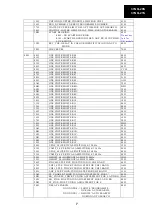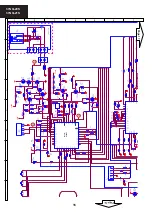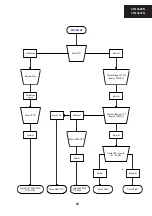
10
37GQ-20S
37GQ-21S
1. HOR POS
a) Receive Philips pattern signal.
b) When
∧
button is pressed, picture moves to the left.
c) When
∨
button is pressed, picture moves to the right.
d) Adjust the horizontal location to obtain picture centering (Fig.1).
•
GEOMETRY ADJUSTMENT PROCEDURE
2. VERT POS
a) Receive Philips pattern signal.
b) When
∧
button is pressed, picture moves up.
c) When
∨
button is pressed, picture moves down.
d) Adjust the vertical location to obtain picture centering (Fig.2).
3. VERT AM
a) Receive Philips pattern signal.
b) When
∧
button is pressed, vertical size of picture increases.
c) When
∨
button is pressed, vertical size of picture decreases.
d) Adjust the vertical size to obtain picture overscan (Fig.3).
The following adjustments are required when the Picture Tube or IC801 are replaced, or
may be necessary after adjustment of the G2 voltage.
1. «B-GAIN», «G-GAIN»
a) Adjust G2.
b) Tune a grey scale pattern.
c) Adjust colour to minimum.
d) Fix R-GAIN value to 50.
e) Position colourmeter in the the left point of Fig.4.
f) Using brightness and contrast buttons, select a luminance of
≈
120 nits.
g) Operate again in Service Mode and select location B-GAIN and
G-GAIN to obtain colour coordinates:
X = 0.290
±
0.015
Y = 0.300
±
0.015
h) Exit Service Mode and check colour coordinates «X» and «Y» at 20 and 120 nits. It may be
necessary to repeat the same procedure or re-adjust the cuts as show the be below one.
2. «G-DC», «R-DC»
a) Adjust G2, in the case that it has not been made previously.
b) Tune a grey scale pattern.
c) Adjust colour to minimum.
e) Position colourmter in the the right point of Fig.4.
f) Using brightness and contrast buttons, select a luminance of
≈
20 nits.
g) Operate again in Service Mode and select location G-DC and R-DC to obtain colour
coordinates:
X = 0.290
±
0.015
Y = 0.300
±
0.015
h) Exit Service Mode and check colour coordinates «X» and «Y» at 20 and 120 nits. It may be
necessary to repeat the same procedure or the previous one.
•
COLOUR ADJUSTMENT (BKGD) PROCEDURES
NOTE:
Locations «R» alter «X» coordinates; «G» alter «Y» coordinates; «B» alter «X» and «Y»
coordinates.
Fig. 2
Fig. 1
Fig. 3
Fig. 4
3 7 4 0
6 5 4 3 2 1 0
(0: Black ... 7: White)
Gain point
DC point











































